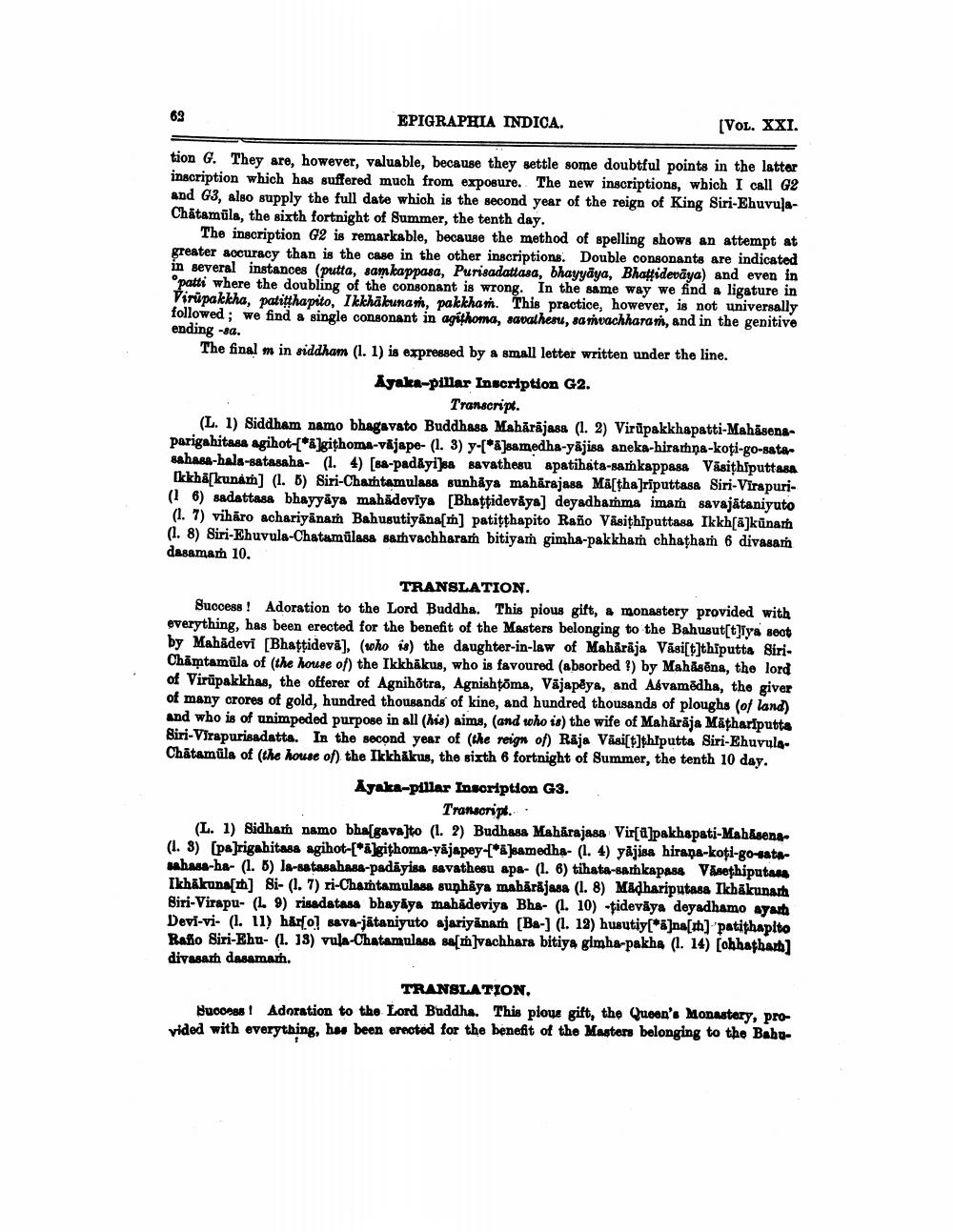________________
62
EPIGRAPHIA INDICA.
[VOL. XXI.
tion G. They are, however, valuable, because they settle some doubtful points in the latter inscription which has suffered much from exposure. The new inscriptions, which I call G2 and G3, also supply the full date which is the second year of the reign of King Siri-EhuvulaChatamula, the sixth fortnight of Summer, the tenth day.
The inscription G2 is remarkable, because the method of spelling shows an attempt at greater accuracy than is the case in the other inscriptions. Double consonants are indicated in several instances (putta, samkappasa, Purisadattasa, bhayyaya, Bhattidevaya) and even in patti where the doubling of the consonant is wrong. In the same way we find a ligature in Virupakkha, patitthapito, Ikkhakunam, pakkham. This practice, however, is not universally followed; we find a single consonant in agithoma, savathesu, samvachharam, and in the genitive ending -sa.
The final m in siddham (1. 1) is expressed by a small letter written under the line.
Ayaka-pillar Inscription G2.
Transcript.
(L. 1) Siddham namo bhagavato Buddhasa Mahārājasa (1. 2) Virüpakkhapatti-Mahasenaparigahitasa agihot-[*]githoma-vajape- (1. 3) y-[*]samedha-yajisa aneka-hiramna-koti-go-satasahasa-hala-satasaha- (1. 4) [sa-padayilsa savathesu apatihata-samkappasa Vasithiputtasa Ikkhakunam] (1. 5) Siri-Chamtamulasa sunhaya maharajasa Mä[tha]riputtasa Siri-Virapuri(16) sadattasa bhayyaya mahadeviya [Bhattidevaya] deyadhamma imam savajätaniyuto (1. 7) viharo achariyanam Bahusutiyana[m] patiṭṭhapito Raño Vasithiputtasa Ikkh[a]kūnam (1. 8) Siri-Ehuvula-Chatamulasa sarvachharam bitiyam gimha-pakkham chhatham 6 divasam dasamam 10.
TRANSLATION.
Success! Adoration to the Lord Buddha. This pious gift, a monastery provided with everything, has been erected for the benefit of the Masters belonging to the Bahusut[t]iya seot by Mahadevi [Bhaṭṭideva], (who is) the daughter-in-law of Maharaja Väsi[t]thiputta SiriChamtamula of (the house of) the Ikkhākus, who is favoured (absorbed ?) by Mahasena, the lord of Virupakkhas, the offerer of Agnihotra, Agnishtöma, Väjapeya, and Aávamedha, the giver of many crores of gold, hundred thousands of kine, and hundred thousands of ploughs (of land) and who is of unimpeded purpose in all (his) aims, (and who is) the wife of Mahārāja Māṭhariputta Siri-Virapurisadatta. In the second year of (the reign of) Raja Väsi[t]thiputta Siri-EhuvulaChatamula of (the house of) the Ikkhākus, the sixth 6 fortnight of Summer, the tenth 10 day.
Ayaka-pillar Inscription G3.
Transcript.
(L. 1) Sidham namo bhalgavalto (1. 2) Budhasa Maharajasa Vir[ü]pakhapati-Mahasena(1.5) (pa)rigahitasa agihot-[*]githoma-ykjapey-[*]amedha- (1. 4) yajisa hiraga-koti-go-satasahasa-ha- (1. 5) la-satasahasa-padayisa savathesu apa- (1. 6) tihata-samkapasa Väsethiputasa Ikhakuna[th] Si- (1. 7) ri-Chamtamulasa suphaya mahārājasa (1. 8) Madhariputasa Ikhakunarh Siri-Virapu- (1. 9) risadatasa bhayaya mahadeviya Bha- (1. 10) -tidevaya deyadhamo ayah Devi-vi- (1. 11) har[o] sava-jätaniyuto ajariyanam [Ba-] (1. 12) husutiy[*]na[th] patithapito Raño Siri-Ehu- (1. 13) vula-Chatamulasa sa[m]vachhara bitiya gimha-pakha (1. 14) [chhatharh] divasam dasamamṁ.
TRANSLATION.
Success! Adoration to the Lord Buddha. This pious gift, the Queen's Monastery, provided with everything, has been erected for the benefit of the Masters belonging to the Bahu




